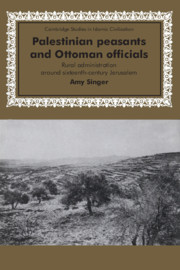Book contents
- Frontmatter
- Contents
- List of maps
- List of tables
- Preface
- Note on transliteration
- Note on money, weights, and measures
- 1 Peasants, Palestine, and the Ottoman Empire
- 2 Aspects of Authority
- 3 The Rules of Local Administration
- 4 Real Accounts and Accounting
- 5 Between Rebellion and Oppression
- 6 Realities and Routines
- Appendices
- Notes
- Bibliography
- Index
1 - Peasants, Palestine, and the Ottoman Empire
Published online by Cambridge University Press: 03 May 2011
- Frontmatter
- Contents
- List of maps
- List of tables
- Preface
- Note on transliteration
- Note on money, weights, and measures
- 1 Peasants, Palestine, and the Ottoman Empire
- 2 Aspects of Authority
- 3 The Rules of Local Administration
- 4 Real Accounts and Accounting
- 5 Between Rebellion and Oppression
- 6 Realities and Routines
- Appendices
- Notes
- Bibliography
- Index
Summary
On August 9, 1555, Ilyas sipahi (cavalry officer), acknowledged before the kadi of Jerusalem that he had received 19 gold dinars and 35 silver pieces from the villagers of 'Ayn Silwān. The peasants had owed him a total of 27 gold dinars as taxes on the revenues from their annual crops and therefore a debt of 7 gold dinars and 5 silver pieces remained outstanding. All of this was carefully noted in the kadi's ledger.
In December 1554, Nasif sipahi sued Aḥmad of the village of Bayt Dhakariyya, which was part of Nasif's timar (income grant), claiming that Aḥmad had been living in another village for two years although he was registered among the peasants of Bayt Dhakariyya. When the district survey register was produced before the kadi in Aḥmad's presence, it confirmed Nasif's claim and he thus requested that Aḥmad be required to return to Bayt Dhakariyya. Aḥmad, for his part, claimed that he could prove his residence in the other village but then conceded that he was still legally a resident of Bayt Dhakariyya, having left the village only three years earlier. Whereupon the kadi ordered him to return to his village and pay his back taxes to Nasif.
Seven peasants who cultivated lands around Jerusalem came before the kadi on July 11, 1553 and sued Mehmet, the official responsible for the immediate surroundings of the city.
- Type
- Chapter
- Information
- Palestinian Peasants and Ottoman OfficialsRural Administration around Sixteenth-Century Jerusalem, pp. 1 - 23Publisher: Cambridge University PressPrint publication year: 1994



